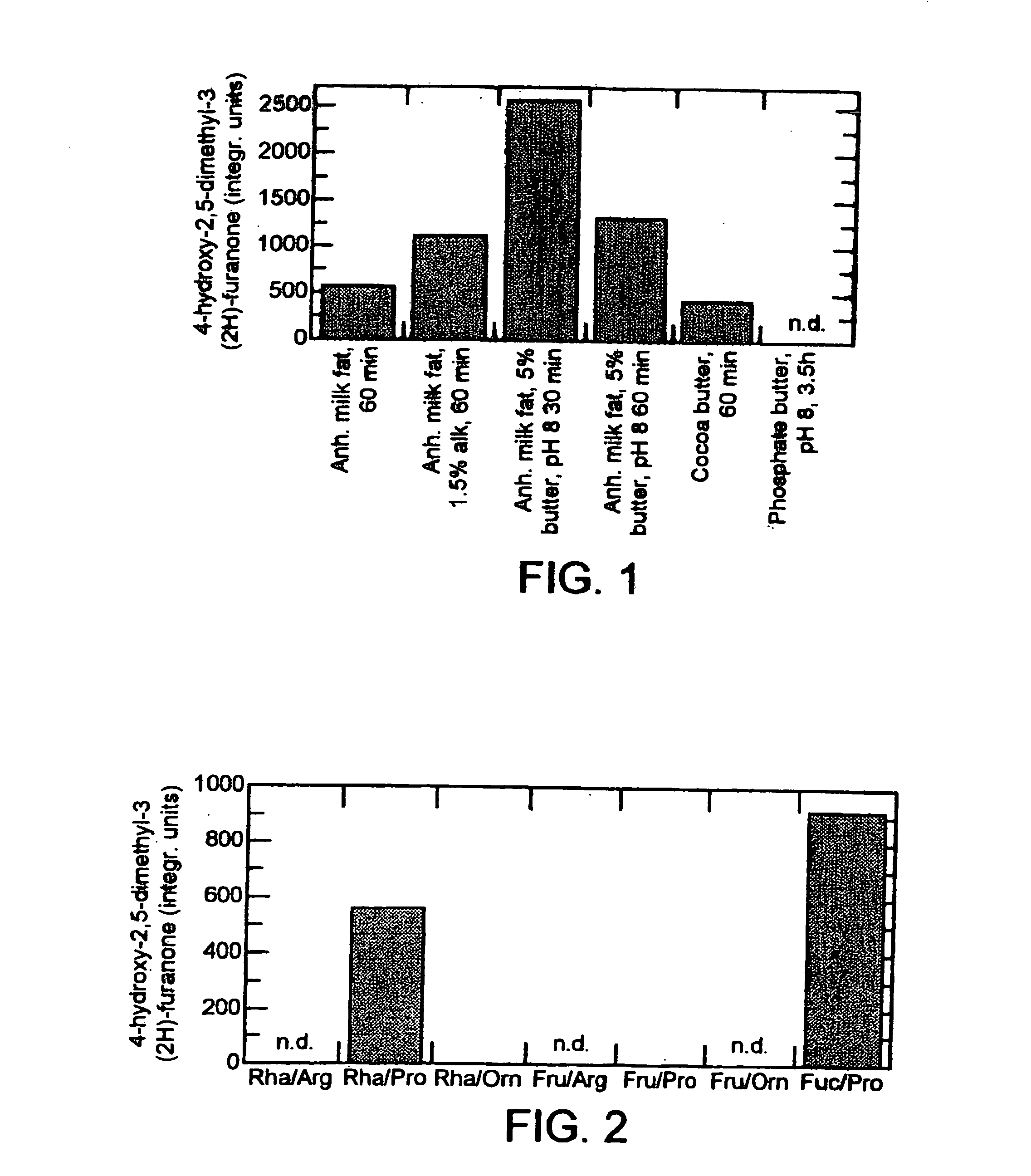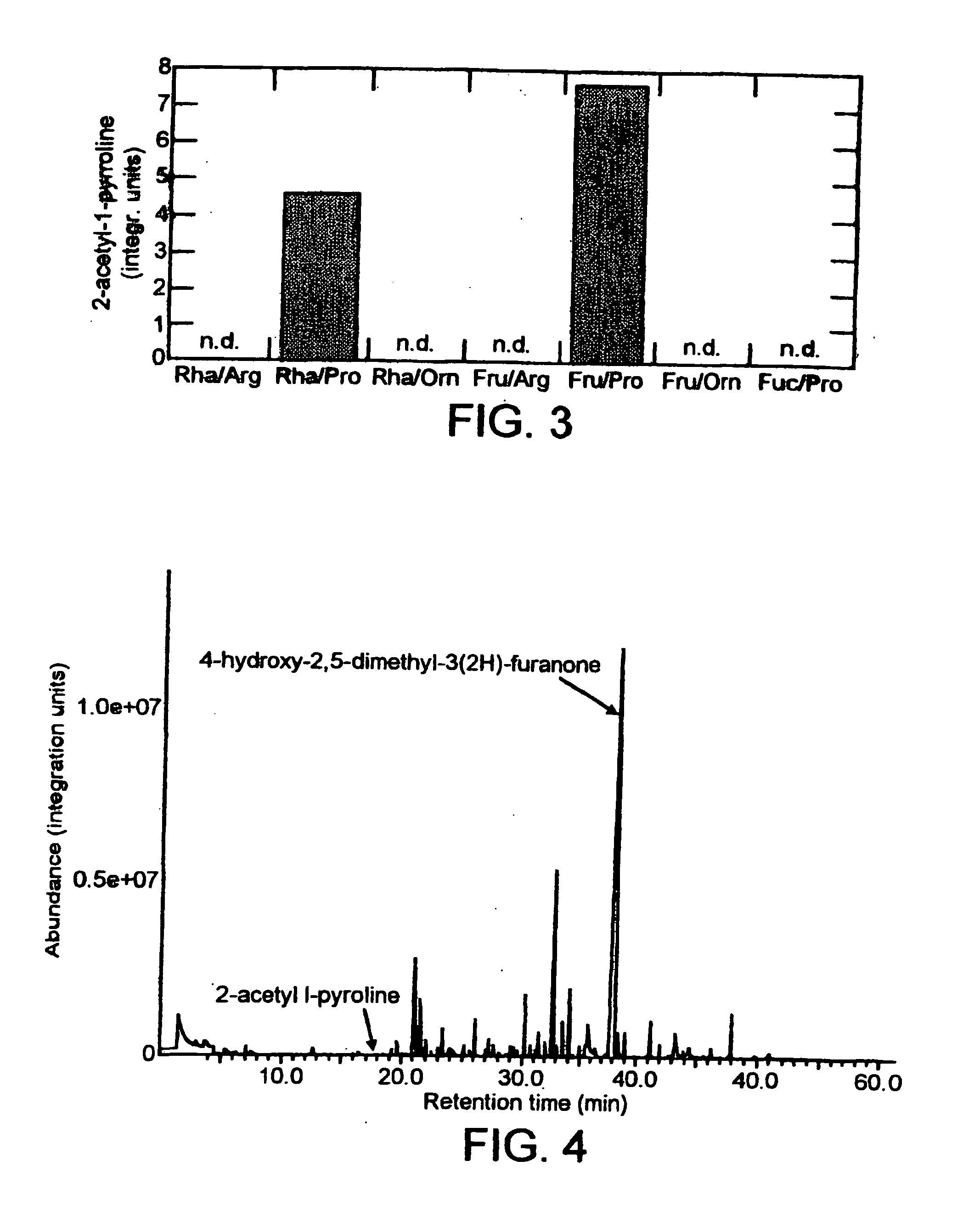Chocolate flavor manipulation
a technology of flavor manipulation and chocolate, applied in the field of chocolate flavor manipulation, can solve the problems that the aroma of the flavor concentrate or attributes may not be linked or limited, and achieve the effect of optimizing asset utilization and cost reduction
- Summary
- Abstract
- Description
- Claims
- Application Information
AI Technical Summary
Benefits of technology
Problems solved by technology
Method used
Image
Examples
example 1
[0054] The flavor reactions were performed in a round bottom 3-necked stirred reactor with temperature control. Anhydrous milk fat (80 g) was melted in the reactor and heated to 125.degree. C. The flavor precursors, rhamnose (50 mM) and proline (50 mM), were added directly with the milk fat or added separately when the temperature of the milk fat had reached 125.degree. C. Rhamnose and proline were reacted in the milk fat for 60 min at 125.degree. C. under reflux. The reacted material was allowed to cool to room temperature and stored at 4.degree. C. or room temperature. The flavor attributes were incorporated at 0.5% level of addition into a chocolate mass.
[0055] Incorporation into Compound:
[0056] One gram of the reaction flavor was added to 199 grams of completely melted compound mass, thoroughly mixed by hand, and molded into 20 gram bars. Following cooling, bars were demolded and allowed to equilibrate to room temperature for at least 4 hours. The samples were allowed to equilib...
example 2
[0061] A flavor reaction was performed according to example 1, except that 1.5% of alkaline water (Stock solution: 4 drops of 50% NaOH in 20 ml water) was added along with the rhamnose and proline. This approach facilitated the reactions at basic pH and increases the solubility of the precursors. Incorporation of 0.5% of the fat-based flavor attribute into chocolate, as described in example 1, resulted in attributes such as caramel, biscuit and cookie. Strongest caramel flavor was achieved after 30 min of reaction.
example 3
[0062] A flavor reaction was performed according to example 1, except that the rhamnose and proline flavor precursors were dissolved in 100 mM Na-phosphate buffer, pH 8 and added when the milk fat had reached a temperature of 100.degree. C. This approach facilitated the reactions at basic pH and increases the solubility of the precursors. The mixture was heated without closing the reactor until most of the moisture had evaporated and the product temperature had reached 125.degree. C. The reaction was continued under reflux at 125.degree. C. Total reaction time was 30-60 min. Incorporation of 0.5% of the fat-based flavor attribute into chocolate, as described in example 1, resulted in attributes such as caramel, biscuit and cookie. Strongest caramel flavor was achieved after 30 min of reaction. The strong caramel flavor was correlated to high 4-hydroxy-2,5-dimethyl-3(2H)-furanone level.
PUM
 Login to View More
Login to View More Abstract
Description
Claims
Application Information
 Login to View More
Login to View More - R&D
- Intellectual Property
- Life Sciences
- Materials
- Tech Scout
- Unparalleled Data Quality
- Higher Quality Content
- 60% Fewer Hallucinations
Browse by: Latest US Patents, China's latest patents, Technical Efficacy Thesaurus, Application Domain, Technology Topic, Popular Technical Reports.
© 2025 PatSnap. All rights reserved.Legal|Privacy policy|Modern Slavery Act Transparency Statement|Sitemap|About US| Contact US: help@patsnap.com


